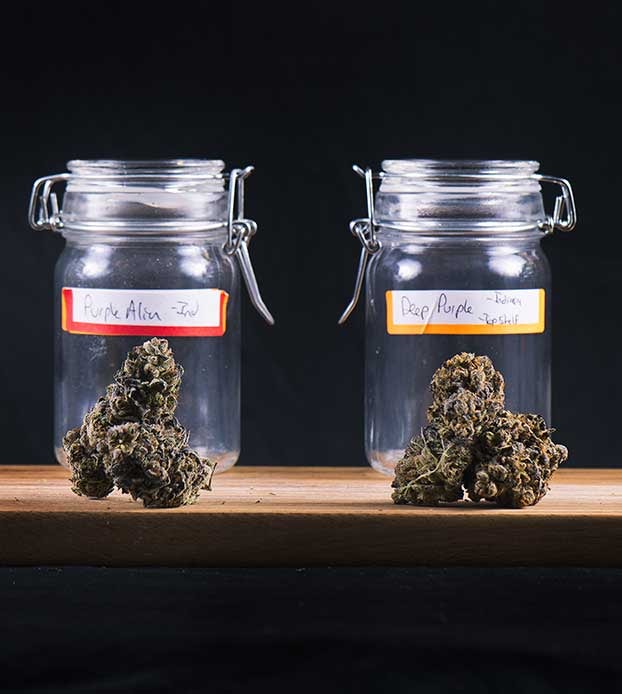Since 2018, hemp has been an ingredient in demand. The sudden explosion in availability has given rise to hemp as the next superfood, beauty product, health supplement, and pet food, specifically for dogs and cats.
It’s increasingly common to find CBD oil (also called hemp oil) in treats and food. But it does beg the question – is it helpful? Is it necessary? Can it do harm?
The endocannabinoid system in dogs and cats
All mammals, including dogs and cats, have an endocannabinoid system (ECS). While our understanding of the ECS is limited, it is an area of growing research.
Scientists still don’t fully appreciate the scope of the ECS’ responsibilities in dogs and cats, but recent studies have shed light on the importance of a healthy ECS in your favorite furry friends.
A 2019 review of the research on the endocannabinoid system in animals said it best: “The endocannabinoid system… plays an integral role in maintaining homeostasis for a number of organ systems. [It] modulates the nervous, immune, and organ systems to relieve pain and inflammation, modulate metabolism and neurologic function, promote healthy digestive processes, and support reproductive function and embryologic development.” 1
The function of an animal’s endocannabinoid system has a large impact on their overall health. Studies have shown:
- An overactive ECS can have a ripple effect that leads to or exacerbates other health problems. 2
- The ECS is “intimately involved in the regulation of most physiological processes in animal systems.”
- A balanced ECS promotes appetite, sleep, mood regulation and stability, coordination, pain perception, memory, body temperature, immunity, reproduction, and fertility in both humans and pets.
As they age, our pet’s ability to produce endocannabinoids is reduced. For this reason, many pet owners find it helpful to include CBD in their pet’s wellness regimen.
The benefits of CBD for dogs and cats
So your pets have an endocannabinoid system – how exactly can CBD help them?
- Pain management. One of the most common areas of study looking at dogs and CBD is arthritis pain. A 2018 study by Gamble et al found that 2 mg of CBD twice a day helped decrease pain and increase activity in the tested dogs. 3
- Controlling seizures. A small 2019 study from Colorado State University found that CBD oil reduced seizures in 89% of dogs when taken alongside prescription epileptic medications. Currently, CSU is studying dosages for epileptic dogs as well as recruiting for a study on postoperative inflammation following cataract surgery.
- Better movement. Dogs don’t have to have arthritis to get stiff and sore as they age or play. CBD has well-documented anti-inflammatory effects that can help dogs move around more after an injury.
- Anxiety management. Exactly how CBD reduces anxiety in animals is still unclear, but just like in humans it could have something to do with serotonin. Because this is one of the most common uses for CBD in pets, it’s beginning to be researched. A study of 16 dogs in 2020 investigated CBD’s anxiolytic capabilities using fireworks as the stimulus. Although the results did not support that CBD reduces Fido’s anxiety, the researchers acknowledged several limitations could have affected the response, including poor timing of the dose. Keeping that in mind, your pet may benefit from a CBD treat before socializing, during firework displays or thunderstorms, and even to help with separation anxiety when you leave the house. 4
- Quality of life. The endocannabinoid system touches nearly every biological function in your pet, and supporting a healthy ECS can improve homeostasis in your pet’s body which can lead to a better quality of life.
Can my dog or cat overdose on CBD?
CBD is generally regarded as safe for people and pets. But can your dog (or cat) overdose on CBD?
The answer is yes, your pet can have too much CBD. But an overdose doesn’t look like you may think. While a high dose of CBD won’t send your pet to the emergency vet the same way ingesting a high-THC brownie might, it can still have negative side effects.
Negative side effects of CBD in dogs can include:
- Dry mouth, which presents as increased thirst
- Drowsiness
- Dizziness from low blood pressure
- Diarrhea / loose stool
Negative side effects of CBD in cats can include:
- Vomiting or gagging
- Drooling or foaming at the mouth
- Pacing
- Licking
In the 2018 Gamble et al study, researchers noted that after four weeks of CBD treatment the liver enzyme values had increased in several of the dogs, which could be a sign of liver stress. However the baseline values for the dogs were already high, hinting that more research is needed to determine whether CBD is harmful on the liver and at what doses.
A small 2019 study examined the effects of 2 mg of CBD in 8 dogs and 8 cats. Researchers noted that adverse reactions were far more common in cats than in dogs and the cats absorbed and metabolized the CBD far slower than the dogs did, though this could be the difference in dosage formulations given to the cats and dogs. Dogs received an infused soft chew and the cats were given an infused fish oil capsule. That alone is a variable when comparing the animals’ responses. The researchers also noted that the cats could have been responding to the fish oil and not necessarily the CBD or dose of it, and the soft chew lacks this ingredient. 5
There isn’t enough research to determine whether a CBD isolate, broad-spectrum, or full-spectrum product is best for pets. The 2018 Gamble et al study of arthritic dogs used a full-spectrum extract that included CBD, CBDa, and other cannabinoids including a small concentration of THC. This formulation was tolerated well by the dogs, however larger amounts of THC are expected to cause more severe side effects. When purchasing a full-spectrum product, be sure to review the lab tests for THC content.
Recommended CBD dose for cats and dogs
There is no standard method or dosage when it comes to giving your pet CBD. Just like humans, dogs and cats come in all sizes and have unique endocannabinoid systems. The general consensus from studies for CBD dosing is commonly somewhere between 0.25 mg and 2 mg per kg of body weight.
- The 2018 study on dogs with arthritis tested two different doses: 2 mg/kg and 8 mg/kg. Researchers found “no observable side effects,” but did find a significant decrease in pain and an increase in activity. However, this study is limited by its small size of only 16 dogs.
- One study by Colorado State University found that a high dose of 20 mg per kg given daily for six weeks was well-tolerated among a group of 30 beagles. But they noted that every dog shared one particular side effect – diarrhea. 6
Best practices for giving dogs and cats CBD
If you’re giving your dog (or cat) CBD for the first time, the golden rule of cannabis remains the same: start low and go slow.
Start with a small dose (like 0.25 per kg) and see how your pet reacts. Give them CBD with food once or twice a day, and keep a close watch on them for the first 7 – 14 days of administration. If there are no side effects but you’re not seeing the results you want, then try increasing the dose. If you do see the results you’re looking for, keep the dose steady and consistent.
As you scale the dose, remember not to go too high or increase too quickly. Aim to give your pet around 2 mg of CBD per kilogram per dose, eg. 25 kg dog x 2 mg per kg = 50 mg dose. Any larger of a dose could increase the risk of side effects, according to the available literature.
Look for a CBD product that’s geared towards pets, has a short ingredient list with minimal additives, and doesn’t have ingredients that are unsafe for dogs like chocolate, xylitol, or essential oils. Always look for a certificate of analysis (COA) to ensure you know what you’re giving your pet.
THC and pets
Contrary to popular belief, THC is not overtly toxic to dogs or cats. But they are particularly sensitive to the effects of this compound and can experience severe adverse reactions.
A study from 1973 tested the effects of THC on beagles, rhesus monkeys, and rats to determine if there was a lethal dose. While the answer was yes in the rats, scientists did not find a lethal amount of THC for the dogs or monkeys. The dogs were given upwards of 26,000 mg and the monkeys, over 42,000 mg. That’s easily more than 5,000 gummies that are dosed at 5 mg, which is an absurd amount to have on hand even for the around-the-clock or constant consumer (not to mention how expensive that would be). But just because eating an edible won’t kill your pet doesn’t mean you should leave them out for them to get into.
Although the toxicity of THC is low, the signs of poisoning can leave your pet feeling extremely uncomfortable. In addition to loose stool and vomiting, pets (dogs in particular) can also experience something called “static ataxia.” This is described as a coordination issue that may present as your dog walking with a swaying gait, staggering around, tilting their head, and/or falling over. This happens as a result of THC interacting with the CB1 receptors in the cerebellum, the balance center of the brain.
Other symptoms of THC ingestion in dogs include urinary incontinence, increased sensitivity to light and sound, decreased body temperature and hypersalivation. 7
Cats can also experience ataxia from cannabis consumption, which may look like awkward or clumsy movement, as well as lack of balance. A 2021 study of 20 cats suggests that while cats can tolerate higher doses of THC, gastrointestinal and neurological adverse effects including ataxia, lethargy, aggression and low body temperature (hypothermia) are common. 8
A 2019 review of endocannabinoid research in animals found that a low “sub-psychotropic” dose of THC can be well tolerated in dogs, meaning the dose is so low it does not cause intoxicating effects. This dose was determined to be between 0.05 – 0.1 mg per kilogram of weight twice daily and was still medicinally effective. 9
Is cannabis poison to dogs?
Just because your dog has an endocannabinoid system doesn’t mean all cannabinoids are good for them. If you’ve ever seen a dog that got into THC, you know it can have dramatically negative effects. But why?
The endocannabinoid systems found in dogs aren’t laid out the same as in humans. They have CB1 and CB2 receptors as we do, but dogs have far more CB1 receptors in their hindbrain, particularly in the cerebellum, brain stem, and medulla oblongata.
The cerebellum is the area of the brain responsible for balance and posture, which may explain why dogs start walking funny when they get into THC. CB1 receptors in dogs are also found in the peripheral nervous system, as well as the cardiovascular, immune, gastrointestinal, and reproductive tissues. Activity in the GI tract might help to explain why THC can cause vomiting or diarrhea in dogs.
Bottom line on pets and CBD
CBD is generally safe for cats and dogs, but just like in humans, every animal’s endocannabinoid system is unique. If you’re starting your pet on CBD, look for a product that is made for animals and has a short ingredient list. Start with a low dose, go slow, and keep an eye on your cat or dog to ensure they’re reacting positively. Keep your veterinarian’s phone number handy just in case.
Sources
- Silver RJ. The Endocannabinoid System of Animals. Animals (Basel). 2019 Sep 16;9(9):686. doi: 10.3390/ani9090686. PMID: 31527410; PMCID: PMC6770351.
- Freundt-Revilla J, Heinrich F, Zoerner A, Gesell F, Beyerbach M, Shamir M, Oevermann A, Baumgärtner W, Tipold A. The endocannabinoid system in canine Steroid-Responsive Meningitis-Arteritis and Intraspinal Spirocercosis. PLoS One. 2018 Feb 6;13(2):e0187197. doi: 10.1371/journal.pone.0187197. PMID: 29408878; PMCID: PMC5800546.
- Gamble LJ, Boesch JM, Frye CW, Schwark WS, Mann S, Wolfe L, Brown H, Berthelsen ES, Wakshlag JJ. Pharmacokinetics, Safety, and Clinical Efficacy of Cannabidiol Treatment in Osteoarthritic Dogs. Front Vet Sci. 2018 Jul 23;5:165. doi: 10.3389/fvets.2018.00165. PMID: 30083539; PMCID: PMC6065210.
- Morris, E. M., Kitts-Morgan, S. E., Spangler, D. M., McLeod, K. R., Costa, J. H. C., & Harmon, D. L. (2020). The Impact of Feeding Cannabidiol (CBD) Containing Treats on Canine Response to a Noise-Induced Fear Response Test. Frontiers in veterinary science, 7, 569565. https://doi.org/10.3389/fvets.2020.569565
- Deabold KA, Schwark WS, Wolf L, Wakshlag JJ. Single-Dose Pharmacokinetics and Preliminary Safety Assessment with Use of CBD-Rich Hemp Nutraceutical in Healthy Dogs and Cats. Animals (Basel). 2019;9(10):832. Published 2019 Oct 19. doi:10.3390/ani9100832
- Martin BR, Dewey WL, Harris LS, Beckner JS. 3H-delta9-tetrahydrocannabinol tissue and subcellular distribution in the central nervous system and tissue distribution in peripheral organs of tolerant and nontolerant dogs. J Pharmacol Exp Ther. 1976 Jan;196(1):128-44. PMID: 1246007.
- Brutlag, A., & Hommerding, H. (2018). Toxicology of Marijuana, Synthetic Cannabinoids, and Cannabidiol in Dogs and Cats. The Veterinary clinics of North America. Small animal practice, 48(6), 1087–1102. https://doi.org/10.1016/j.cvsm.2018.07.008
- Kulpa JE, Paulionis LJ, Eglit GM, Vaughn DM. Safety and tolerability of escalating cannabinoid doses in healthy cats. Journal of Feline Medicine and Surgery. 2021;23(12):1162-1175. doi:10.1177/1098612X211004215
- Silver R. J. (2019). The Endocannabinoid System of Animals. Animals : an open access journal from MDPI, 9(9), 686. https://doi.org/10.3390/ani9090686
Sign up for bi-weekly updates, packed full of cannabis education, recipes, and tips. Your inbox will love it.

 Shop
Shop Support
Support



















